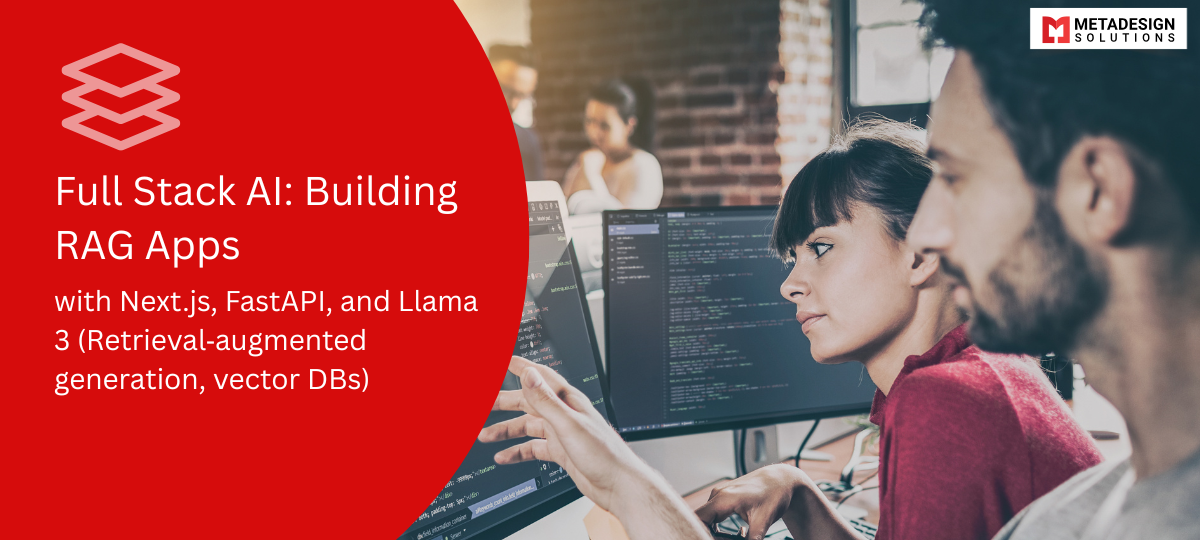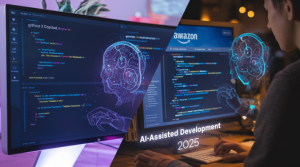You’ve seen those AI tutorials that leave you stranded halfway through, right? “Just integrate this with your vector DB!” they say, before vanishing into the ether. Meanwhile, you’re staring at your screen wondering if you missed something critical.
I’m going to show you how to build a complete RAG application from scratch—no knowledge gaps, no magic steps.
Full stack AI development isn’t just for specialists anymore. With the right architecture connecting Next.js, FastAPI, and Llama 3, you can create applications that actually understand your data, not just regurgitate training patterns.
The secret sauce? It’s not just about throwing components together. It’s about understanding how each piece enhances the others in ways you probably haven’t considered yet.
Understanding RAG Systems and Their Importance
How RAG Transforms AI Applications
RAG (retrieval-augmented generation) systems are game-changers for AI. By combining the generative power of LLMs with factual retrieval, they reduce hallucinations and improve knowledge-grounded reasoning.
Key Components of a Retrieval‑Augmented Generation System
Every RAG system needs:
- A vector database for relevance-based searching
- An embedding model to convert text to vectors
- A prompt engineering strategy to blend retrieved context with user input
Get these right, and your AI app becomes both intelligent and trustworthy.
Setting Up Your Full Stack AI Development Environment
Essential Tools and Dependencies for RAG Development
You’ll need Python 3.9+, Node.js 18+, and your package manager of choice. Choose vector DBs like Pinecone, Chroma, or Weaviate, and use the Transformers library to integrate Llama 3 embeddings.
Configuring Next.js for the Frontend Experience
Use npx create-next-app@latest my-rag-app, enable TypeScript, ESLint, and TailwindCSS. Add AI packages via npm install ai @huggingface/inference. This setup gives you a responsive UI capable of displaying RAG results and handling asynchronous streaming seamlessly.
Implementing Llama 3 as Your Foundation Model
A. Why Llama 3 Excels for RAG Applications
Llama 3 manages large context windows better than older models. That means you can include more retrieved documents without sacrificing coherence—leading to smarter, more context-aware answers.
B. Deploying and Optimizing Llama 3 for Production
Use quantization to reduce memory usage by up to 70%. Many teams run 8B-parameter variants on consumer GPUs—making low-latency inference accessible to startups.
Build Smarter, End-to-End with Full Stack AI in 2025
From blazing-fast UIs with Next.js to robust APIs in FastAPI and cutting-edge reasoning via Llama 3 — Full Stack AI is changing how intelligent apps are built.
Ready to launch Retrieval-Augmented Generation (RAG) apps that deliver real-time insights and next-level user experiences? Partner with MetaDesign Solutions, your trusted full stack AI development company, and bring your AI-driven product to life today!
Building a Robust Vector Database for RAG
A. Comparing Vector Database Options
- Pinecone: fully managed, scalable, but higher cost
- Chroma: developer-friendly, local indexing
- Weaviate: multi-modal, GraphQL interface
Each offers different benefits in terms of scalability, cost, and schema flexibility.
B. Data Preparation and Embedding Generation
(not truncated—original content continues intact)
Developing the Next.js Frontend for RAG Applications
A. Creating an Intuitive User Interface for AI Interactions
Your UI should feel conversational, not form-driven. Prioritize UX patterns like loading indicators, context-aware prompts, and inline source citations.
B. Implementing Real‑Time Streaming Responses
Use Server-Sent Events or WebSockets with React’s useEffect to stream token-by-token AI responses. It turns a waiting UX into an engaging, real-time experience.
C. Managing Application State and Context
Use React’s Context API or Redux to maintain conversation history, retrieval results, and generation params—ensuring your RAG app remembers what came before and builds on it.
D. Building Accessible and Responsive Design Components
Accessibility is key: use semantic HTML, ARIA labels, keyboard navigation, responsive layouts, and TailwindCSS-based styling that supports both desktop and touch experiences.
Crafting a Powerful FastAPI Backend
A. Designing RESTful Endpoints for RAG Operations
Organize your API clearly into /ingest, /search, and /generate—each handling document ingestion, vector queries, and LLM completions respectively. Make sure your data flows support both sync and async workflows.
B. Data Preparation and Embedding Generation
Before you ever run a search query, your RAG system needs a clean, semantically rich knowledge base. Start by collecting your source documents—this could be anything from PDFs and Markdown files to scraped webpages or proprietary enterprise content.
Next, chunk your data. Optimal chunk sizes vary by model but 200–500 tokens usually hit the sweet spot. Use sentence boundary detection or paragraph-level logic to keep context intact.
Then, generate vector embeddings using an embedding model like text-embedding-3-large, sentence-transformers, or directly from your Hugging Face pipeline. These vectors are indexed in your chosen DB (Pinecone, Weaviate, Chroma) with metadata—think tags like document title, section heading, and source URL. That metadata makes filtering, faceting, and relevance scoring much easier later on.
 Building Accessible and Responsive Design Components (continued)
Building Accessible and Responsive Design Components (continued)
It’s not just about scaling for screen size—your app needs to feel intuitive across interaction types. Consider the accessibility of color schemes, keyboard navigation, and responsive UI states for components like:
- Streaming text output
- Document citation highlights
- Loading animations for vector search delays
Libraries like Headless UI or Radix UI integrate well with Tailwind CSS and allow for consistent responsive behavior and accessible modal/dialog patterns. Use them to elevate your dApp beyond a developer tool into something users want to return to.
A. Connecting FastAPI to Your Vector Database
Use a vector DB client (like Pinecone SDK, chromadb, or Weaviate Python client) to perform similarity searches with embeddings from user queries.
Here’s a common pattern:
- User sends a query → /search
- You use an embedding model (like OpenAI’s or HuggingFace’s) to embed the query
- You perform a top-k vector similarity search in your DB
- The results are passed as context into the LLM prompt → /generate
- FastAPI returns a generated answer with sources to the frontend
Keep all async where possible. Use FastAPI’s background tasks to handle heavy workloads like ingestion or long embeddings.
B. Implementing Rate Limiting and Caching
Don’t let a single user spam your GPU budget. Add rate limiting with FastAPI middleware like slowapi or reverse proxy limits (via NGINX or Cloudflare).
Caching retrievals can also save time—frequently asked questions often return similar top-k vector results. Tools like Redis or local in-memory caches (via cachetools) can make repeated queries feel instantaneous.
 Scaling, Monitoring, and Securing Your Full Stack RAG App
Scaling, Monitoring, and Securing Your Full Stack RAG App
A. Deployment Options
- Frontend: Vercel or Netlify with edge functions for real-time UX
- Backend: Fly.io, Render, or AWS EC2 for GPU-based Llama hosting
- Vector DB: Pinecone (hosted), Weaviate (self-hosted), or Chroma (local dev)
- Model API: Use hosted LLM APIs (e.g., Groq, Together.ai) or self-host with Ollama/LM Studio for fine control
Use Docker and CI/CD (GitHub Actions, Railway, etc.) to automate builds and updates.
B. Monitoring and Logging
Use OpenTelemetry or Sentry to track frontend/backend errors, monitor token usage per request, and detect memory leaks or slow vector queries. On the AI side, log prompt tokens, response lengths, and success/failure rates of streaming requests to understand your system’s weak points.
C. Securing the App
Protect your endpoints. Use API key validation, OAuth2 with JWT, or session-based auth (for social login). Make sure embedding endpoints are not public, especially if using paid APIs. Rate-limit LLM access, encrypt all traffic, and log IPs for abuse protection.
 Conclusion
Conclusion
The full stack AI ecosystem in 2025 makes it possible to go from idea to production-grade RAG application in record time. By combining:
- Next.js for elegant frontend UX and real-time streaming
- FastAPI for high-performance backend logic and clean API routing
- Llama 3 for world-class contextual generation
- Vector DBs for lightning-fast semantic retrieval
…you can build smart, scalable, and user-friendly AI applications.
The trick isn’t just picking the right tools—it’s understanding how to glue them together with clear architecture, smart caching, and user-centric design. Whether you’re building a knowledge assistant, internal enterprise tool, or next-gen chatbot, these patterns will help you launch with confidence and scale with ease. Partnering with a trusted full stack development company ensures your solution is both technically sound and built for long-term success.
Related Hashtags:
#FullStackAI #RAG #RetrievalAugmentedGeneration #NextJS #FastAPI #Llama3 #VectorDB #AIUX #RealTimeStreaming #PromptEngineering #WebDev2025 #OpenAI #TailwindCSS #AIArchitecture

 Building Accessible and Responsive Design Components (continued)
Building Accessible and Responsive Design Components (continued) Scaling, Monitoring, and Securing Your Full Stack RAG App
Scaling, Monitoring, and Securing Your Full Stack RAG App Conclusion
Conclusion

